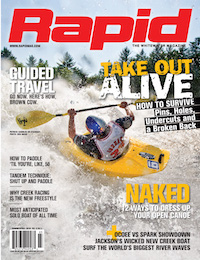Chile’s Michimahuida River is a long and committing day run in a steep, isolated valley in northern Patagonia. the glacier-capped mountains through which the river tumbles are volcanic and troubled by frequent eruptions that turn the turquoise waters pasty grey. In 2009, Theresa Landman and her husband Bob Daffe put on the Michimahuida with a party of four other kayakers 10 months after the most recent explosion of volcanic ash and just two days before another eruption. After the group roped down a hillside of mud and ash, an otherwise clean descent turned ugly in the river’s second canyon. Landman explains what went wrong.
I have been whitewater kayaking for 20 years and paddled lots of class IV–V rivers in Chile, Argentina, Africa, Mexico, New Zealand, Ecuador, Nepal, the United States and Canada. Bob had paddled the Michimahuida in 2006.
In the second canyon, I ended up in a chute with many shallow rocks in pushy water and flipped. I tried to roll up but my paddle blade hit a rock as my arm was fully extended. I actually heard a popping sound and wondered if it was my shoulder. I had no choice but to let go of my paddle and work my way out of my kayak with one arm. I started to swim, concerned that I would get swept into the heart of the rapid. I was lucky to wash onto a mid-river rock in a slower section of the rapid.
When Bob arrived, I was clutching my arm across my chest in the telltale position for shoulder dislocation. He set up a rescue on a tether to get me to shore. I wanted to keep my shoulder and arm in the least excruciating position but I had to remove my lifejacket and dry top so Bob could examine the injury. He sent the group ahead to finish the river before dark, leaving just the two of us with a bit of food and spare clothes.
Bob had set dislocated shoulders seven times before and was optimistic mine would go in. I lay as flat as I could on the rocks and Bob placed his foot against the side of my chest and pulled my arm straight. When he applied traction, the pressure and pain eased. After 15 minutes, we heard a distinct click as my shoulder muscles relaxed. Bob gently moved my arm upwards and I felt my shoulder slide back into place. It was instant relief for both of us, despite the fact that we were on our own and a cold, heavy rain had begun.
SEEKING MEDICAL ATTENTION
To progress downriver, I bushwacked through a thick forest of bamboo and Nalga (a giant, Chilean equivalent of Devil’s Club) while Bob paddled the rapids on his own, waiting every 100 metres. Where the river was calmer, I held onto the back of Bob’s boat while he paddled. Eventually, Bob spotted my kayak floating in an eddy. I began paddling easier sections interspersed with difficult portages. At dusk we spotted a cave that became our home for the night. We made a fire to dry our gear and slept in our paddling clothes.
At daybreak, we found the river in flood and the class V rapids impassable. Bob now had to portage two boats over house-sized rocks and around cliffs. Where portaging wasn’t an option, we got back in our boats. I flipped once and tried to roll, but my shoulder was too weak so I went back under and rolled up on my offside. We reached the takeout at 10:30 a.m. to find that our group had initiated a rescue. At the police station they told us that a helicopter was on its way but couldn’t fly due to the bad weather.
I saw a doctor in Chile who made sure the shoulder was back in properly and that there were no other injuries. They put my arm in a sling and gave me some painkillers.
I am now more cautious around holes. To improve my strength and confidence, I exercise my shoulder regularly with a Thera-Band.
SHOULDER DISLOCATION 101
- Shoulder dislocation is the most common acute traumatic injury in kayaking.
- Surgery is required in 13 per cent of acute paddling-related shoulder injuries.
- Reductions should only be performed by trained individuals in the backcountry where evacuation is lengthy and difficult. If a dislocation occurs in the frontcountry, seek treatment at a hospital rather than attempting reduction on the river.
- Following a simple reduction, immobilize shoulder in a sling for five to seven days.
- 95 per cent of all shoulder dislocations are anterior, meaning the head of the humerus (upper arm bone) is pushed forward out of the shoulder socket.
- The U.S. Canoe and Kayak Federation recommends back paddling as an effective exercise for increasing strength and stability of anterior shoulder muscles.
Theresa Landman and Bob Daffe own and operate Tatshenshini Expeditions in the Yukon.




